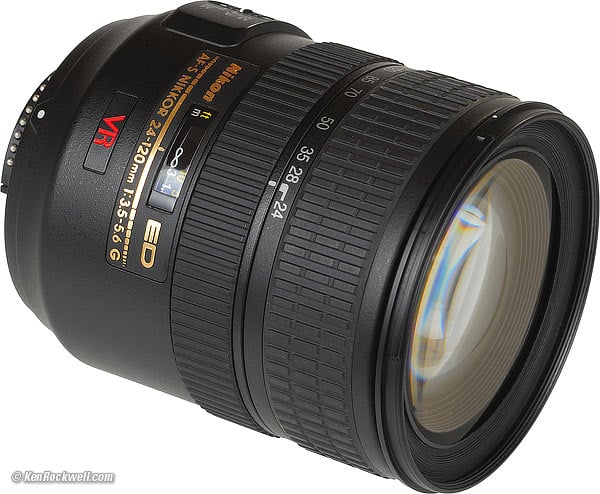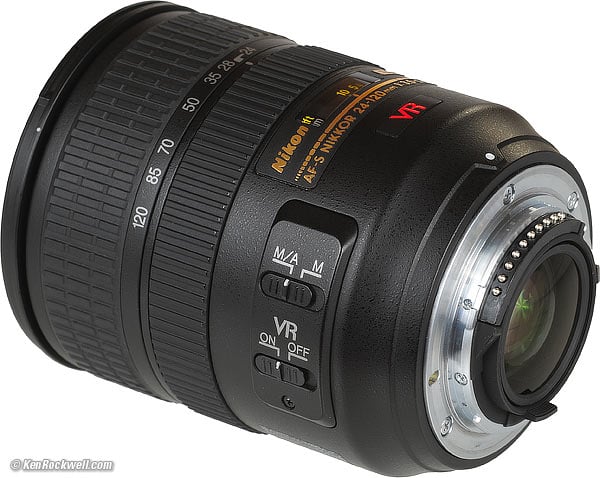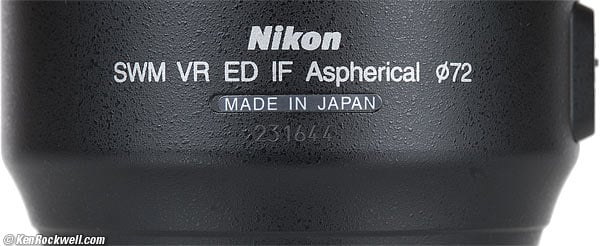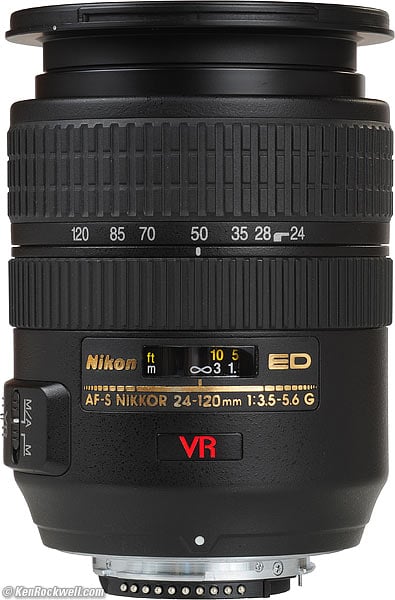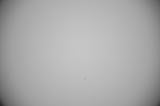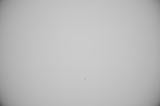Home Donate New Search Gallery How-To Books Links Workshops About Contact
Nikon 24-120mm VR
AF-S NIKKOR f/3.5-5.6 (2003-2010)
© 2008 KenRockwell.com. All rights reserved.
Intro Specifications Performance Recommendations
Nikon 24-120mm f/3.5-5.6 NOT RECOMMENDED (one of Nikon's 10 worst lenses of all time). enlarge. I'd get mine at Adorama, Amazon, or Ritz. It helps me keep adding to this site when you use these links to get yours. Thanks! Ken.
NEW: Nikon 24-120mm f/4 VR (2010-)
see also old 24-120mm AF-D (1996-2002)
October 2010, August 2008 More Nikon Reviews Nikon Lens Reviews
Sharpness Comparison to all other 24mm lenses August 2010
| Optics: | |
| Ergonomics: | |
| Usefulness: | |
| Availability: | |
| Overall: |
Ideal Uses
4x6" vacation snapshots on print film, paperweight, lazy man's do-everything zoom for FX digital and film, body cap. The VR system is excellent, so it's great for shooting still (not moving) subjects hand-held in low light, where this lens' lack of sharpness isn't an issue. Its lack of sharpness will help eliminate aliasing (moiré) if you have problems with other lenses when shooting fabric and other repeating fine patterns.
Not for
I wouldn't bother with this lens on a digital or serious film camera. Its specs look great on paper, and it was the first lens I put on my D3, but it's optically poor. There are much better choices. Skip this for DX digital; get the superior 18-200mm DX VR instead. This G (gelded) lens won't work on manual-focus film cameras.
Introduction top
Intro Specifications Performance Recommendations
Compatibility History Production Pricing
The 24-120mm VR is among Nikon's 10 worst lenses of all time. This is because it's not sharp at the wide end (even stopped down), vignettes at the long end, and it's slow (about f/5 for most of the range). Considering that it's expensive ($510), it's just not acceptable. Other lenses are much better for less money.
The best thing about the 24-120 VR is its excellent VR system, which really does let me make great, perfectly tripod-sharp shots hand-held at down to 1/4 second throughout most of the zoom range, and down to 1/8 second at 120mm.
There is only one version of this 24-120 VR lens, and they all say "VR" on the outside. Nikon says "VR II" in its advertising, which means this lens uses a different VR system than the VR system of the first 80-400mm VR. There are no other versions of the 24-120 VR.
Nikon 24-120mm VR. enlarge.
Compatibility back to intro back to top
|
I personally suggest Adorama, Amazon, Ritz, B&H, Calumet and J&R. I can't vouch for ads below.
|
Everything works perfectly on every digital Nikon, both FX and DX.
It's also perfect on decent or recent AF film cameras like the F6, F100, F5, N80 and N75.
The incompatibilities for older or cheaper film cameras are that:
1.) It won't autofocus with the cheapest new AF film cameras like the N55, but if you focus manually, everything else works great. Even if you lose autofocus, these cameras have in-finder focus confirmation dots to help you.
2.) Late 1980s ~ early 1990s AF cameras like the N90s, N70 and F4 will focus just fine, but you'll lose VR. You'll have Program and Shutter-priority modes, but lose Manual and Aperture-priority since you have no way to set the aperture on the camera or on the lens.
3.) You're really pushing it with the oldest AF cameras like the N2020, N6006 and N8008. No AF, confused exposure modes, and no VR. Manual focus is fine, along with electronic focus indications.
4.) Since it has no aperture ring, it's just about useless with manual focus film cameras.
See Nikon Lens Compatibility for details on your camera. Read down the "AF-S, AF-I" and "G" and "VR" columns for this lens. You'll get the least of all the features displayed in all columns, since "G" (gelding) is a handicap which removes features.
History back to intro back to top
1996-2002: Nikon's first AF 24-120mm lens was called the "streetsweeper" by newsmen because you could always keep it on a body, and it covered enough of a range to let you shoot just about anyone or anything immediatlety in an emergency.
2003: Nikon introduced this completely different lens, adding VR and AFS for instant manual-focus override.
Production back to intro back to top
Nikon had made about 125,000 of these 24-120 VR lenses, so far. Nikon made about 250,000 of the older version 24-120mm.
Pricing back to intro back to top
The 24-120 VR has always sold at about $510 if you know where to buy. Retail is usually higher.
Price, new* |
Corrected for inflation, 2008 |
|
2003 |
$540 |
$640 |
2005 |
$510 |
$575 |
2008 |
$510 |
$510 |
2010 |
$580 |
$570 |
* At full NYC discount.
Specifications with commentary top
Intro Specifications Performance Recommendations
Name: Nikon calls this the Nikon AF-S VR Zoom-Nikkor 24-120mm f/3.5-5.6G IF-ED.
AF-S and SWM: Silent Wave (focus) Motor.
VR: Vibration Reduction.
ED: ED Glass.
IF: Internal Focusing.
Aspherical: Aspherical elements.
G: Gelded for cost-reduction and removing compatibility with older cameras.
Optics: 15 elements in 13 groups. Two are of ED glass, two are aspherical.
Close Focus: 1.6 feet (0.5m). This is not quite as close as the 24-85 AF-S but close enough for all sorts of fun.
Maximum Reproduction Ratio: 1:4.8.
Hard Infinity Focus Stop? No.
Focus Scale: Yes.
Depth-of-Field Scale: No.
Infra-Red Focus Index: No.
Diaphragm: 7 blades, rounded. Stops down to f/22 at 24mm, and to f/36 at 120mm.
Aperture Ring: No.
Filter Thread: 72mm, plastic. Never rotates.
Size: Nikon specifies 3.7" (94mm) extension from flange and 3.0" (77mm) diameter.
Weight: 20.045 oz. (568.3g), as measured. Nikon specifies 20 oz (575g).
Hood: HB-25 plastic bayonet hood, included.
Teleconverters: Forget about it. At f/5.6, it makes no sense.
Introduced: PMA, March 2003.
Available: The 24-120 was hard to get until 2004.
Nikon Product Number: 2145, current as of Spring 2008.
Price: $510, USA in 2008.
Nikon 24-120 VR. enlarge.
Performance top
Intro Specifications Performance Recommendations
Overall Focus Color Distortion Ergonomics Falloff Filters
Lateral Color Fringes Maximum Aperture Mechanics Sharpness
Overall back to Performance back to top
The Nikon 24-120mm VR is among Nikon's softest lenses of the past few decades. To make things worse, it also has a lot of falloff, or darkening of the corners.
It can work very well on an N80 film camera as a lightweight vacation camera for prints, but if you worry about pixels and sharpness, you'll hate this 24-120mm. Many people thought it was soft even back in film days, when it was much tougher to see lens defects.
Focus back to Performance back to top
AF
AF is excellent and fast.
Manual Focus
Manual focus is easy: just move the ring at any time with a fingertip.
M/A - M Switch
Nikon goofed. This switch is supposed to be labeled "A - M."
The "M/A" position means autofocus. It's called "M/A" because back in the old days, when Nikon had almost caught up to Canon who had been doing this for ten years before, Nikon was trying to show off that you could focus manually while in the AF position.
Paint over the extra M if you're easily confused.
Color Rendition back to Performance back to top
The color rendition seems the same as all my other modern Nikkor lenses.
Distortion back to performance back to top
On FX and film, it has complex (wavy) but not particularly bad distortion at 24mm, and strong pincushion (sucking) distortion at 50mm and longer.
The pincushion distortion can be corrected by plugging these figures into Photoshop CS2's lens distortion filter. The wide-angle distortion on FX is complex, and doesn't correct completely with this tool. These aren't facts or specifications, they are the results of my research that requires hours of photography and calculations on the resulting data.
On FX and Film at infinity |
Visible Effects |
|
24mm |
Wavy distortion: Center bulges while sides pull out. |
+2.0* |
28mm |
Sides pull out. |
-1.0* |
35mm |
Pincushion. |
-3.0* |
50mm |
Strong Pincushion. |
-4.0 |
70mm |
Strong Pincushion. |
-4.0 |
85mm |
Strong Pincushion. |
-4.0 |
120mm |
Strong Pincushion. |
-4.0 |
© 2008 KenRockwell.com. All rights reserved.
* Waviness remains.
On DX at infinity |
Visible Effects |
|
24mm |
Barrel (bulging) distortion. |
+3.0 |
28mm |
Mild Barrel. |
+1.5 |
35mm |
none. |
0.0 |
50mm |
mild pincushion |
-1.0 |
70mm |
mild pincushion |
-1.2 |
85mm |
mild pincushion |
-1.5 |
120mm |
mild pincushion |
-1.0 |
© 2008 KenRockwell.com. All rights reserved.
Ergonomics (handling and ease-of-use) back to performance back to top
The 24-120mm VR is OK, but not that great either.
Zooming is mediocre, and the manual focus adjustment doesn't feel that impressive.
Falloff (darkened corners) back to performance back to top
Falloff on FX is a problem at both ends of the zoom range. it doesn't improve much when stopped down, and since the 24-120 is so slow anyway, you're usually shooting wide open in most conditions.
I can see this in real photos, and its one of the reasons I dislike this lens.
It might be an issue on DX, too (see crop factor).
These gray fields on a gray background usually exaggerate falloff with good lenses, but in this case, the actual results in real photos is a little bit worse than you you see below.
Nikon 24-120mm f/3.5-5.6 VR falloff on FX and film at infinity, uncorrected.
|
Filters, Use with back to Performance back to top
The filter ring does not rotate.
Avoid thick filters with film and FX. You just might get some additional vignetting, and the 24-120mm has enough of its own without adding to the problem.
Using a 72->77mm step up ring almost works, but it does vignette just the tiniest bit of the corners when used with a typical 5mm thick 77mm filter.
Lateral Color Fringes back to Performance back to top
There are no lateral color fringes on the D3, but bigger problems are softness and vignetting in the corners.
Maximum Aperture back to Performance back to top
24mm |
f/3.5 |
28mm |
f/3.8 |
35mm |
f/4 |
38mm |
f/4.2 |
45mm |
f/4.5 |
50mm |
f/4.8 |
60mm |
f/5 |
70mm |
f/5.3 |
85mm |
f/5.6 |
120mm |
f/5.6 |
Mechanics back to Performance back to top
The 24-120 VR is a tough plastic lens. It's got metal where it needs it, and plastic everywhere else.
Barrel Exterior: Plastic.
Filter Threads: Plastic.
Hood: Plastic bayonet.
Focus Ring: Plastic.
Zoom Ring: Plastic with rubber insert.
Depth-of-Field Scale: None.
Internals: Metal and plastic.
Aperture Ring: None.
Mount: Dull-chromed brass.
Markings: Paint.
Identity Plate: Embossed and planed metal.
Serial Number: Laser engraved onto bottom of barrel, below lens information.
Ass-Gasket (dust seal at mount): No.
Noises When Shaken: Moderate clicking.
Made in: Japan, but notice how Nikon has designed this lens so that all they have to do when production moves to Thailand, China, Laos or Tibet is to use a different sticker.
Sharpness back to Performance back to top
Warning 1: Image sharpness depends more on you than your lens.
Warning 2: Lens sharpness doesn't mean much to good photographers.
With those caveats, the 24-120mm AF-S is among Nikon's softest lenses of all time. For 4x6" prints from film (as shot by most Leica film aficionados) it's great, but if you worry enough to read reviews like this, steer clear of this one.
It's sharp enough in the center, but the sides and corners are poor if you look reasonably closely. For most photography this is fine, but it drives me crazy.
This 24-120 VR is soft wide-open on the sides of FX, which would be forgivable, except that it doesn't get sharper stopped down. The sides are fuzzy at 24mm on FX, and don't get better when stopped down to f/8 as every other lens does.
Nikon's MTF curves at the bottom of this page show us that this is the way this lens is designed. See how the curve falls to zero at the right? That means the image degrades to mush at the corners. These curves are wide-open. The unshown problem is that the MTF stopped down doesn't improve, as it does with almost all other lenses.
At 24-70mm: It's OK in the center at every aperture, but the sides and corners are both vignetted (dark) and fuzzy.
At 120mm: At f/5.6, it's not as soft in the corners, but it's softer overall. It's less bad at f/8.
VR Measurements back to performance back to top
VR works great. It lets me get great shots of still subjects in light 2 or 3 stops darker than without VR. Of course for half the price of this lens what I really shoot most of the time is the 50mm f/1.4 AF-D, which really is 3.5 stops faster than this lens, and those 3.5 real stops give improvements when shooting moving targets which VR can't.
By "sharp shots" I mean perfect tripod-equivalent sharpness when viewed at 100%, as shot on a D3 by me. I was standing straight up with only my feet on the ground, and wasn't practicing any careful match-style breathing: I just shot.
For most uses, one can use much slower speeds. See Why VR Matters for more.
VR OFF
| % Sharp Shots | 1 |
1/2 |
1/4 |
1/8 |
1/15 |
1/30 |
1/60 |
1/125 |
1/250 |
| 24mm | 0 |
0 |
0 |
33 |
85 |
100 |
100 |
100 |
100 |
| 50mm | 0 | 0 |
0 |
45 |
50 |
100 |
100 |
100 |
100 |
| 70mm | 0 | 0 |
0 |
20 |
25 |
60 |
90 |
100 |
100 |
| 120mm | 0 | 0 |
0 |
0 |
5 |
50 |
75 |
100 |
100 |
VR ON
| % Sharp Shots | 1 |
1/2 |
1/4 |
1/8 |
1/15 |
1/30 |
1/60 |
1/125 |
1/250 |
| 24mm | 15 |
0 |
80 |
100 |
100 |
100 |
100 |
100 |
100 |
| 50mm | 15 | 20 |
50 |
100 |
100 |
100 |
100 |
100 |
100 |
| 70mm | 0 | 5 |
50 |
80 |
100 |
100 |
90 |
100 |
100 |
| 120mm | 0 | 0 |
33 |
45 |
80 |
85 |
90 |
90 |
100 |
Lowest speeds for perfectly sharp shots 50% of the time
% Sharp Shots |
VR OFF |
VR ON |
Real Stops Improvement |
Marketing Stops Improvement |
24mm |
1/10 |
1/3 |
1.7 |
3 |
50mm |
1/15 |
1/4 |
2 |
3.6 |
70mm |
1/30 |
1/4 |
3 |
4 |
120mm |
1/30 |
1/8 |
2 |
4 |
"Real Stops" are how many extra stops I get over shooting without VR. "Marketing stops" is improvement over the old-wives' tale of 1/focal length as a lower speed limit.
Zooming back to Performance back to top
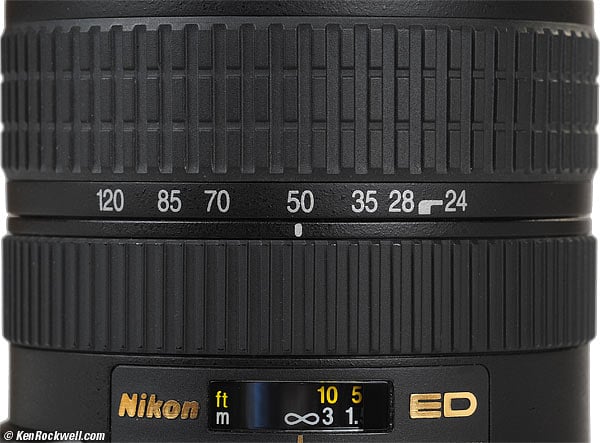
Nikkor 24-120mm Zoom and Focus Rings.
Zooming is only fair because the wide focal lengths are all bunched together.
See how 24mm and 28mm are so close together that Nikon had to cheat and use a line to position 24mm? This makes setting precise framing a pain at the wide end. Other lenses are much better.
EXIF Encoding Accuracy
Encoded focal lengths agree to with a few millimeters of the setting on the ring.
Compared to other Nikon lenses
back to Performance back to top
24-120mm "Streetsweeper"
The VR is a little longer and a little skinnier than the original Streetsweeper.
Optically, the Streetsweeper isn't winning any awards, but it seems better than the VR at 24mm. I also prefer the feel of the larger and better spaced zoom ring.
AF is also super-fast, and close-focus is the same.
Other Midrange Zooms
I'd prefer just about anything to this lens.
I'd go get a used 28-105mm, 28-70mm f/3.5-4.5 or 24-85mm AFS instead.
If you need a broader zoom range go ahead and get the 24-120mm, but I'm not a fan of it.
Recommendations top
Intro Specifications Performance Recommendations
The 24-120mm VR is not likely to make you happy if you buy it for use on a D3 or D700. It's not sharp, and it the corners are often dark.
I'd get another lens instead. I'd save up for the 24-70mm f/2.8, or get a used 28-105mm, 28-70mm f/3.5-4.5 or 24-85mm AFS instead. It's easy to find the 28-105mm used at Adorama for about $170.
Deployment
I'd leave either a 72mm Nikon Clear (NC - UV) filter, or a 72mm Hoya Super HMC UV on the lens at all times. I would leave the hood at home.
If I was going to use this as part of a larger pro system, I'd attach a 72->77mm step-up-ring to convert this to today's pro standard of 77mm, and use a 77mm Nikon UV or Hoya UV filter for protection.
If I was working in nasty, dirty areas, I'd forget the cap, and use an uncoated 72mm Tiffen UV filter instead (or in 77mm). Uncoated filters are much easier to clean, but more prone to ghosting.
More Information: Nikon, Japan.
Help me help you top
I support my growing family through this website, as crazy as it might seem.
If you find this as helpful as a book you might have had to buy or a workshop you may have had to take, feel free to help me continue helping everyone.
If you've gotten your gear through one of my links or helped otherwise, you're family. It's great people like you who allow me to keep adding to this site full-time. Thanks!
If you haven't helped yet, please do, and consider helping me with a gift of $5.00.
The biggest help is to use these links to Adorama, Amazon, Calumet, Ritz and J&R when you get your goodies. It costs you nothing and is a huge help. These places have the best prices and service, which is why I've used them since before this website existed. I recommend them all personally.
Thanks for reading!
Ken
Home Donate New Search Gallery How-To Books Links Workshops About Contact

